Monday, April 22, 2024
19C Mythical Goddess Flora - Symbol of Spring
"Passover" - Judaism Religious Rituals depicted in 1707
The woodcuts in the book cover Sabbath & holiday observance, & home & synagogue rituals. Among them area mother blessing the Sabbath lights of a Sabbath oil lamp;a father chanting the Havdalah (service of "separation" at the conclusion of the Sabbath), while he holds a cup of wine by the light of a candle held by a child whose sibling holds a spice box; 4 men blessing the new moon;a rabbi preaching on the Great Sabbath (preceding Passover); grinding flour for & baking matzoh; searching for chametz (leaven); & scouring pots & pans. Also shown are a man having his hair cut on Lag B'Omer--the 33rd day of the 50 between Passover & Shavuot, when restrictions obtaining during that period of mourning are relaxed; Moses on Sinai receiving the Ten Commandments; worshipers seated on the floor on Tisha B'Av, mourning the destruction of the Temple; the sounding of the shofar on Rosh Hashanah, the New Year; a man building his tabernacle for the Feast of Tabernacles; the gathering of palms, willows, & myrtle to join the citron in its celebration; children receiving sweets to celebrate the Joy of the Law, Simhat Torah; the kindling of a Hanukkah lamp; & Purim jesters sounding their musical instruments.
The life cycle is also marked: bride & groom under the huppah (canopy); an infant boy entering the Covenant of Abraham; & finally, a body borne in a coffin to its eternal resting place. These are some of the 1707 woodcuts:
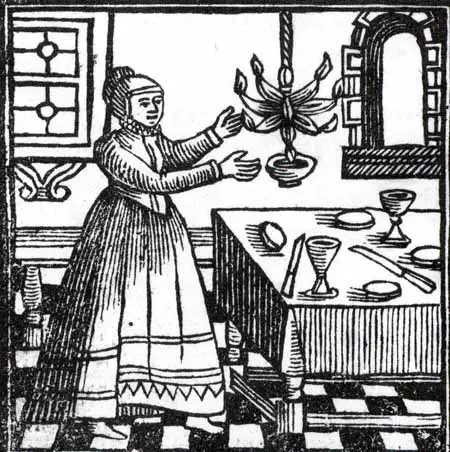


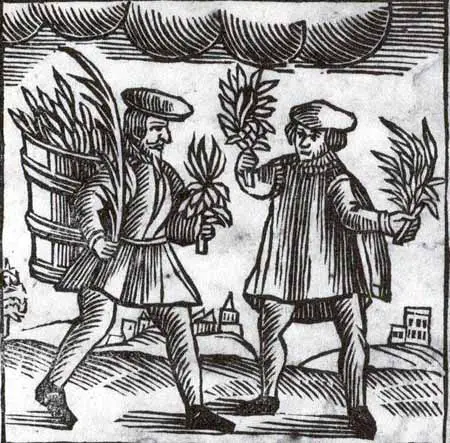
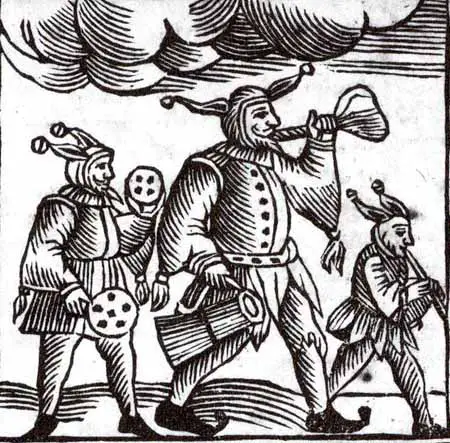
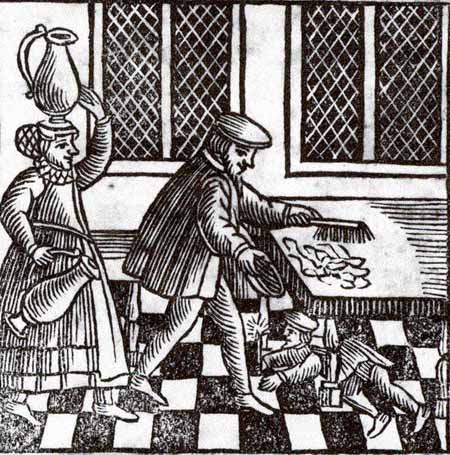
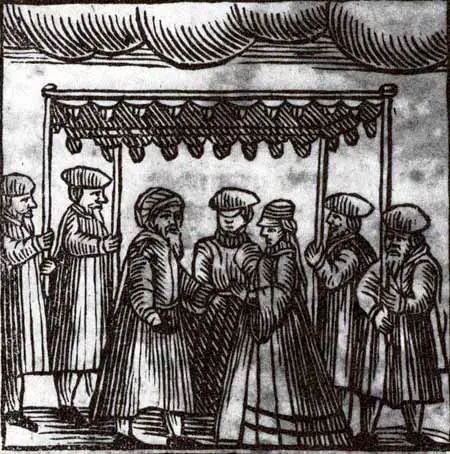

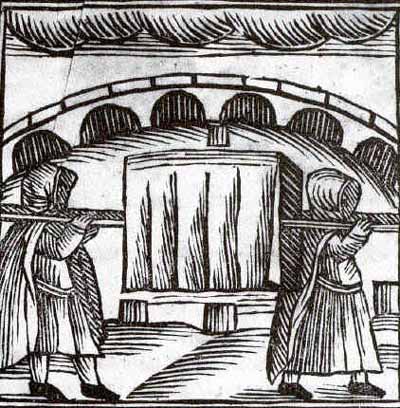
Sunday, April 21, 2024
Earth's Creatures Stop to Smell the Flowers
Spring often means it is time for you & your pet to explore the great outdoors. But before you & your furry best friend stop & smell the spring flowers, make sure they are not toxic. If you suspect your pet has ingested or been in contact with the plants below, call Pet Poison Helpline ASAP & then contact your veterinary team to keep them updated on the situation.
See Toxic & Non-Toxic Plant List - Dogs https://www.aspca.org/pet-care/animal-poison-control/dogs-plant-list
Toxic and Non-Toxic Plant List - Cats https://www.aspca.org/pet-care/animal-poison-control/cats-plant-list
These services provide immediate expert advice, and include consultation with your veterinarian if needed. Follow-up of the case is also included, if needed.
Animal Poison Control Center (ASPCA): 888-426-4435
Pet Poison Helpline: 855-764-7661
17C Mythical Goddess Flora - Symbol of Spring
Saturday, April 20, 2024
Earth's Creatures Stop to Smell the Flowers
Spring & Summer are the perfect time to celebrate the rebirth of Earth's Beauty & Bounty. Flowers gave beauty & inspiration to mankind's basic struggle to live & to populate & to protect his home-base, the Earth. Holding on to The Sweet Divine - The Lord God took man & put him in the Garden of Eden to work it & to keep it...Genesis 2:15.
The expression "stop to smell the flowers" came into popular modern use in the 1960s & is a rephrasing of a sentiment found in a 1956 autobiography written by the golfer Walter Hagen: “Don’t hurry. Don’t worry. And be sure to smell the flowers along the way.”
18C Mythical Goddess Flora - Symbol of Spring
Friday, April 19, 2024
Earth's Creatures Stop to Smell the Flowers
“The beautiful Spring came, & when nature resumes her loveliness, the human soul is apt to revive also.” – Harriet Ann Jacobs
Spring often means it is time for you & your pet to explore the great outdoors. But before you & your furry best friend stop & smell the spring flowers, make sure they are not toxic. If you suspect your pet has ingested or been in contact with the plants below, call Pet Poison Helpline ASAP & then contact your veterinary team to keep them updated on the situation.
See Toxic & Non-Toxic Plant List - Dogs https://www.aspca.org/pet-care/animal-poison-control/dogs-plant-list
Toxic and Non-Toxic Plant List - Cats https://www.aspca.org/pet-care/animal-poison-control/cats-plant-list
These services provide immediate expert advice, and include consultation with your veterinarian if needed. There is a fee, so have a credit card handy. Followup of the case is also included, if needed.
Animal Poison Control Center (ASPCA): 888-426-4435
Pet Poison Helpline: 855-764-7661
These are the top 3 flowers to avoid:
LILIES
Important note: Extremely dangerous for cats.The entire lily family should be avoided by your pet. They contain toxic alkaloids that are extremely dangerous if ingested, especially for cats. True lilies & daylilies are particularly harmful—just a small amount of ingested pollen can cause deadly toxicity in cats. Dogs are slightly more resistant to the toxicity of lilies, but they can become itchy if exposed to these flowers or have some GI upset if they ingest them.
BEGONIAS
Avoid: Begonia grandis, wax begonias, double begonias, fimbriata begonias. These flowers thrive in the springtime, & their stems—particularly the part rooted underground—can cause acute toxicity if ingested by dogs & cats. Similar to our version of hot sauce, if eaten, begonias can result in an extreme burning in your pet’s mouth, swollen tongue or lips, & even difficulty swallowing. If you suspect your pet has swallowed a begonia stem or bulb, take them to an emergency veterinary office for immediate treatment.
AZALEAS
Important note: Just a few ounces of azalea flowers are enough to cause severe toxicity in a large-sized dog. These shrub plants come in a variety of sizes & colors & give off a lovely smell. But, when it comes to azaleas, their beauty should be appreciated from afar as they are toxic to all pets, including horses. These flowers can disrupt the cells in an animal's body, which can cause symptoms from blindness & vomiting, to abnormal heart rate or even death. Make sure to avoid: Formosa azaleas, spider azaleas, Gumpbo pink azaleas, rhododendrons.
18C Mythical Goddess Flora - Symbol of Spring
Thursday, April 18, 2024
Earth's Creatures Stop to Smell the Flowers
Spring often means it is time for you & your pet to explore the great outdoors. But before you & your furry best friend stop & smell the spring flowers, make sure they are not toxic. If you suspect your pet has ingested or been in contact with the plants below, call Pet Poison Helpline ASAP & then contact your veterinary team to keep them updated on the situation.
See Toxic & Non-Toxic Plant List - Dogs https://www.aspca.org/pet-care/animal-poison-control/dogs-plant-list
Toxic and Non-Toxic Plant List - Cats https://www.aspca.org/pet-care/animal-poison-control/cats-plant-list
These services provide immediate expert advice, and include consultation with your veterinarian if needed. There is a fee, so have a credit card handy. Followup of the case is also included, if needed.
Animal Poison Control Center (ASPCA): 888-426-4435
Pet Poison Helpline: 855-764-7661
These are the top 3 flowers to avoid:
LILIES
Important note: Extremely dangerous for cats.The entire lily family should be avoided by your pet. They contain toxic alkaloids that are extremely dangerous if ingested, especially for cats. True lilies & daylilies are particularly harmful—just a small amount of ingested pollen can cause deadly toxicity in cats. Dogs are slightly more resistant to the toxicity of lilies, but they can become itchy if exposed to these flowers or have some GI upset if they ingest them.
BEGONIAS
Avoid: Begonia grandis, wax begonias, double begonias, fimbriata begonias. These flowers thrive in the springtime, & their stems—particularly the part rooted underground—can cause acute toxicity if ingested by dogs & cats. Similar to our version of hot sauce, if eaten, begonias can result in an extreme burning in your pet’s mouth, swollen tongue or lips, & even difficulty swallowing. If you suspect your pet has swallowed a begonia stem or bulb, take them to an emergency veterinary office for immediate treatment.
AZALEAS
Important note: Just a few ounces of azalea flowers are enough to cause severe toxicity in a large-sized dog. These shrub plants come in a variety of sizes & colors & give off a lovely smell. But, when it comes to azaleas, their beauty should be appreciated from afar as they are toxic to all pets, including horses. These flowers can disrupt the cells in an animal's body, which can cause symptoms from blindness & vomiting, to abnormal heart rate or even death. Make sure to avoid: Formosa azaleas, spider azaleas, Gumpbo pink azaleas, rhododendrons.
Wednesday, April 17, 2024
Earth's Creatures Stop to Smell the Flowers
Spring often means it is time for you & your pet to explore the great outdoors. But before you & your furry best friend stop & smell the spring flowers, make sure they are not toxic. If you suspect your pet has ingested or been in contact with the plants below, call Pet Poison Helpline ASAP & then contact your veterinary team to keep them updated on the situation.
See Toxic & Non-Toxic Plant List - Dogs https://www.aspca.org/pet-care/animal-poison-control/dogs-plant-list
Toxic and Non-Toxic Plant List - Cats https://www.aspca.org/pet-care/animal-poison-control/cats-plant-list
These services provide immediate expert advice, and include consultation with your veterinarian if needed. There is a fee, so have a credit card handy. Followup of the case is also included, if needed.
Animal Poison Control Center (ASPCA): 888-426-4435
Pet Poison Helpline: 855-764-7661
These are the top 3 flowers to avoid:
LILIES
Important note: Extremely dangerous for cats.The entire lily family should be avoided by your pet. They contain toxic alkaloids that are extremely dangerous if ingested, especially for cats. True lilies & daylilies are particularly harmful—just a small amount of ingested pollen can cause deadly toxicity in cats. Dogs are slightly more resistant to the toxicity of lilies, but they can become itchy if exposed to these flowers or have some GI upset if they ingest them.
BEGONIAS
Avoid: Begonia grandis, wax begonias, double begonias, fimbriata begonias. These flowers thrive in the springtime, & their stems—particularly the part rooted underground—can cause acute toxicity if ingested by dogs & cats. Similar to our version of hot sauce, if eaten, begonias can result in an extreme burning in your pet’s mouth, swollen tongue or lips, & even difficulty swallowing. If you suspect your pet has swallowed a begonia stem or bulb, take them to an emergency veterinary office for immediate treatment.
AZALEAS
Important note: Just a few ounces of azalea flowers are enough to cause severe toxicity in a large-sized dog. These shrub plants come in a variety of sizes & colors & give off a lovely smell. But, when it comes to azaleas, their beauty should be appreciated from afar as they are toxic to all pets, including horses. These flowers can disrupt the cells in an animal's body, which can cause symptoms from blindness & vomiting, to abnormal heart rate or even death. Make sure to avoid: Formosa azaleas, spider azaleas, Gumpbo pink azaleas, rhododendrons.
Tuesday, April 16, 2024
Earth's Creatures Stop to Smell the Flowers
“The first real day of Spring is like the first time a boy holds your hand. A flood of skin-tingling warmth consumes you, & everything shines with a fresh, colorful glow, making you forget that anything as cold & harsh as winter ever existed.” – Richelle E. Goodrich
Spring often means it is time for you & your pet to explore the great outdoors. But before you & your furry best friend stop & smell the spring flowers, make sure they are not toxic. If you suspect your pet has ingested or been in contact with the plants below, call Pet Poison Helpline ASAP & then contact your veterinary team to keep them updated on the situation.
See Toxic & Non-Toxic Plant List - Dogs https://www.aspca.org/pet-care/animal-poison-control/dogs-plant-list
Toxic and Non-Toxic Plant List - Cats https://www.aspca.org/pet-care/animal-poison-control/cats-plant-list
These services provide immediate expert advice, and include consultation with your veterinarian if needed. There is a fee, so have a credit card handy. Followup of the case is also included, if needed.
Animal Poison Control Center (ASPCA): 888-426-4435
Pet Poison Helpline: 855-764-7661
These are the top 3 flowers to avoid:
LILIES
Important note: Extremely dangerous for cats.The entire lily family should be avoided by your pet. They contain toxic alkaloids that are extremely dangerous if ingested, especially for cats. True lilies & daylilies are particularly harmful—just a small amount of ingested pollen can cause deadly toxicity in cats. Dogs are slightly more resistant to the toxicity of lilies, but they can become itchy if exposed to these flowers or have some GI upset if they ingest them.
BEGONIAS
Avoid: Begonia grandis, wax begonias, double begonias, fimbriata begonias. These flowers thrive in the springtime, & their stems—particularly the part rooted underground—can cause acute toxicity if ingested by dogs & cats. Similar to our version of hot sauce, if eaten, begonias can result in an extreme burning in your pet’s mouth, swollen tongue or lips, & even difficulty swallowing. If you suspect your pet has swallowed a begonia stem or bulb, take them to an emergency veterinary office for immediate treatment.
AZALEAS
Important note: Just a few ounces of azalea flowers are enough to cause severe toxicity in a large-sized dog. These shrub plants come in a variety of sizes & colors & give off a lovely smell. But, when it comes to azaleas, their beauty should be appreciated from afar as they are toxic to all pets, including horses. These flowers can disrupt the cells in an animal's body, which can cause symptoms from blindness & vomiting, to abnormal heart rate or even death. Make sure to avoid: Formosa azaleas, spider azaleas, Gumpbo pink azaleas, rhododendrons.
18C Mythical Goddess Flora - Symbol of Spring
Monday, April 15, 2024
Earth's Creatures Stop to Smell the Flowers
Spring often means it is time for you & your pet to explore the great outdoors. But before you & your furry best friend stop & smell the spring flowers, make sure they are not toxic. If you suspect your pet has ingested or been in contact with the plants below, call Pet Poison Helpline ASAP & then contact your veterinary team to keep them updated on the situation.
See Toxic & Non-Toxic Plant List - Dogs https://www.aspca.org/pet-care/animal-poison-control/dogs-plant-list
Toxic and Non-Toxic Plant List - Cats https://www.aspca.org/pet-care/animal-poison-control/cats-plant-list
These services provide immediate expert advice, and include consultation with your veterinarian if needed. There is a fee, so have a credit card handy. Followup of the case is also included, if needed.
Animal Poison Control Center (ASPCA): 888-426-4435
Pet Poison Helpline: 855-764-7661
These are the top 3 flowers to avoid:
LILIES
Important note: Extremely dangerous for cats.The entire lily family should be avoided by your pet. They contain toxic alkaloids that are extremely dangerous if ingested, especially for cats. True lilies & daylilies are particularly harmful—just a small amount of ingested pollen can cause deadly toxicity in cats. Dogs are slightly more resistant to the toxicity of lilies, but they can become itchy if exposed to these flowers or have some GI upset if they ingest them.
BEGONIAS
Avoid: Begonia grandis, wax begonias, double begonias, fimbriata begonias. These flowers thrive in the springtime, & their stems—particularly the part rooted underground—can cause acute toxicity if ingested by dogs & cats. Similar to our version of hot sauce, if eaten, begonias can result in an extreme burning in your pet’s mouth, swollen tongue or lips, & even difficulty swallowing. If you suspect your pet has swallowed a begonia stem or bulb, take them to an emergency veterinary office for immediate treatment.
AZALEAS
Important note: Just a few ounces of azalea flowers are enough to cause severe toxicity in a large-sized dog. These shrub plants come in a variety of sizes & colors & give off a lovely smell. But, when it comes to azaleas, their beauty should be appreciated from afar as they are toxic to all pets, including horses. These flowers can disrupt the cells in an animal's body, which can cause symptoms from blindness & vomiting, to abnormal heart rate or even death. Make sure to avoid: Formosa azaleas, spider azaleas, Gumpbo pink azaleas, rhododendrons.
Spring 17C by Grégoire Huret (French, 1606-1670)
18C Mythical Goddess Flora - Symbol of Spring
Sunday, April 14, 2024
Earth's Creatures Stop to Smell the Flowers
“With the coming of Spring, I am calm again.” – Gustav Mahler
Spring & Summer are the perfect time to celebrate the rebirth of Earth's Beauty & Bounty. Flowers gave beauty & inspiration to mankind's basic struggle to live & to populate & to protect his home-base, The Earth. Holding on to The Sweet Divine - The Lord God took man & put him in the Garden of Eden to work it & to keep it...Genesis 2:15.
The expression came into popular modern use in the 1960s & is a rephrasing of a sentiment found in an autobiography written by the golfer Walter Hagen: “Don’t hurry. Don’t worry. And be sure to smell the flowers along the way.”
18C Mythical Goddess Flora - Symbol of Spring
%20-%20Henriette%20of%20France%20as%20Flora.jpg)
Saturday, April 13, 2024
Earth's Creatures Stop to Smell the Flowers
“Come with me into the woods. Where Spring is advancing, as it does, no matter what, not being singular or particular, but one of the forever gifts...” – Mary Oliver
Spring often means it is time for you & your pet to explore the great outdoors. But before you & your furry best friend stop & smell the spring flowers, make sure they are not toxic. If you suspect your pet has ingested or been in contact with the plants below, call Pet Poison Helpline ASAP & then contact your veterinary team to keep them updated on the situation.
See Toxic & Non-Toxic Plant List - Dogs https://www.aspca.org/pet-care/animal-poison-control/dogs-plant-list
Toxic and Non-Toxic Plant List - Cats https://www.aspca.org/pet-care/animal-poison-control/cats-plant-list
These services provide immediate expert advice, and include consultation with your veterinarian if needed. There is a fee, so have a credit card handy. Followup of the case is also included, if needed.
Animal Poison Control Center (ASPCA): 888-426-4435
Pet Poison Helpline: 855-764-7661
These are the top 3 flowers to avoid:
LILIES
Important note: Extremely dangerous for cats.The entire lily family should be avoided by your pet. They contain toxic alkaloids that are extremely dangerous if ingested, especially for cats. True lilies & daylilies are particularly harmful—just a small amount of ingested pollen can cause deadly toxicity in cats. Dogs are slightly more resistant to the toxicity of lilies, but they can become itchy if exposed to these flowers or have some GI upset if they ingest them.
BEGONIAS
Avoid: Begonia grandis, wax begonias, double begonias, fimbriata begonias. These flowers thrive in the springtime, & their stems—particularly the part rooted underground—can cause acute toxicity if ingested by dogs & cats. Similar to our version of hot sauce, if eaten, begonias can result in an extreme burning in your pet’s mouth, swollen tongue or lips, & even difficulty swallowing. If you suspect your pet has swallowed a begonia stem or bulb, take them to an emergency veterinary office for immediate treatment.
AZALEAS
Important note: Just a few ounces of azalea flowers are enough to cause severe toxicity in a large-sized dog. These shrub plants come in a variety of sizes & colors & give off a lovely smell. But, when it comes to azaleas, their beauty should be appreciated from afar as they are toxic to all pets, including horses. These flowers can disrupt the cells in an animal's body, which can cause symptoms from blindness & vomiting, to abnormal heart rate or even death. Make sure to avoid: Formosa azaleas, spider azaleas, Gumpbo pink azaleas, rhododendrons.
18C Print of Spring

17C Mythical Goddess Flora - Symbol of Spring
Friday, April 12, 2024
Earth's Creatures Stop to Smell the Flowers
Spring often means it is time for you & your pet to explore the great outdoors. But before you & your furry best friend stop & smell the spring flowers, make sure they are not toxic. If you suspect your pet has ingested or been in contact with the plants below, call Pet Poison Helpline ASAP & then contact your veterinary team to keep them updated on the situation.
See Toxic & Non-Toxic Plant List - Dogs https://www.aspca.org/pet-care/animal-poison-control/dogs-plant-list
Toxic and Non-Toxic Plant List - Cats https://www.aspca.org/pet-care/animal-poison-control/cats-plant-list
These services provide immediate expert advice, and include consultation with your veterinarian if needed. There is a fee, so have a credit card handy. Followup of the case is also included, if needed.
Animal Poison Control Center (ASPCA): 888-426-4435
Pet Poison Helpline: 855-764-7661
These are the top 3 flowers to avoid:
LILIES
Important note: Extremely dangerous for cats.The entire lily family should be avoided by your pet. They contain toxic alkaloids that are extremely dangerous if ingested, especially for cats. True lilies & daylilies are particularly harmful—just a small amount of ingested pollen can cause deadly toxicity in cats. Dogs are slightly more resistant to the toxicity of lilies, but they can become itchy if exposed to these flowers or have some GI upset if they ingest them.
BEGONIAS
Avoid: Begonia grandis, wax begonias, double begonias, fimbriata begonias. These flowers thrive in the springtime, & their stems—particularly the part rooted underground—can cause acute toxicity if ingested by dogs & cats. Similar to our version of hot sauce, if eaten, begonias can result in an extreme burning in your pet’s mouth, swollen tongue or lips, & even difficulty swallowing. If you suspect your pet has swallowed a begonia stem or bulb, take them to an emergency veterinary office for immediate treatment.
AZALEAS
Important note: Just a few ounces of azalea flowers are enough to cause severe toxicity in a large-sized dog. These shrub plants come in a variety of sizes & colors & give off a lovely smell. But, when it comes to azaleas, their beauty should be appreciated from afar as they are toxic to all pets, including horses. These flowers can disrupt the cells in an animal's body, which can cause symptoms from blindness & vomiting, to abnormal heart rate or even death. Make sure to avoid: Formosa azaleas, spider azaleas, Gumpbo pink azaleas, rhododendrons.
Spring 1601-1650 Garden in Background
Spring & "springtime" refer to the ecological, environmental season, and also to ideas of rebirth, rejuvenation, renewal, resurrection & regrowth.
17C Allegory of Spring at a Market Scene
Thursday, April 11, 2024
Earth's Creatures Stop to Smell the Flowers
“Despite the forecast, live like it’s Spring.” – Lilly Pulitzer
Spring & Summer are the perfect time to celebrate the rebirth of Earth's Beauty & Bounty. Flowers gave beauty & inspiration to mankind's basic struggle to live & to populate & to protect his home-base, The Earth. Holding on to The Sweet Divine - The Lord God took man & put him in the Garden of Eden to work it & to keep it...Genesis 2:15.
The expression came into popular modern use in the 1960s & is a rephrasing of a sentiment found in an autobiography written by the golfer Walter Hagen: “Don’t hurry. Don’t worry. And be sure to smell the flowers along the way.”
18C Spring Allegory from the Italian School
Wednesday, April 10, 2024
Earth's Creatures Stop to Smell the Flowers
Spring often means it is time for you & your pet to explore the great outdoors. But before you & your furry best friend stop & smell the spring flowers, make sure they are not toxic. If you suspect your pet has ingested or been in contact with the plants below, call Pet Poison Helpline ASAP & then contact your veterinary team to keep them updated on the situation.
See Toxic & Non-Toxic Plant List - Dogs https://www.aspca.org/pet-care/animal-poison-control/dogs-plant-list
Toxic and Non-Toxic Plant List - Cats https://www.aspca.org/pet-care/animal-poison-control/cats-plant-list
These services provide immediate expert advice, and include consultation with your veterinarian if needed. There is a fee, so have a credit card handy. Followup of the case is also included, if needed.
Animal Poison Control Center (ASPCA): 888-426-4435
Pet Poison Helpline: 855-764-7661
These are the top 3 flowers to avoid:
LILIES
Important note: Extremely dangerous for cats.The entire lily family should be avoided by your pet. They contain toxic alkaloids that are extremely dangerous if ingested, especially for cats. True lilies & daylilies are particularly harmful—just a small amount of ingested pollen can cause deadly toxicity in cats. Dogs are slightly more resistant to the toxicity of lilies, but they can become itchy if exposed to these flowers or have some GI upset if they ingest them.
BEGONIAS
Avoid: Begonia grandis, wax begonias, double begonias, fimbriata begonias. These flowers thrive in the springtime, & their stems—particularly the part rooted underground—can cause acute toxicity if ingested by dogs & cats. Similar to our version of hot sauce, if eaten, begonias can result in an extreme burning in your pet’s mouth, swollen tongue or lips, & even difficulty swallowing. If you suspect your pet has swallowed a begonia stem or bulb, take them to an emergency veterinary office for immediate treatment.
AZALEAS
Important note: Just a few ounces of azalea flowers are enough to cause severe toxicity in a large-sized dog. These shrub plants come in a variety of sizes & colors & give off a lovely smell. But, when it comes to azaleas, their beauty should be appreciated from afar as they are toxic to all pets, including horses. These flowers can disrupt the cells in an animal's body, which can cause symptoms from blindness & vomiting, to abnormal heart rate or even death. Make sure to avoid: Formosa azaleas, spider azaleas, Gumpbo pink azaleas, rhododendrons.
17C Mythical Goddess Flora - Symbol of Spring

Tuesday, April 9, 2024
Earth's Creatures Stop to Smell the Flowers
Spring often means it is time for you & your pet to explore the great outdoors. But before you & your furry best friend stop & smell the spring flowers, make sure they are not toxic. If you suspect your pet has ingested or been in contact with the plants below, call Pet Poison Helpline ASAP & then contact your veterinary team to keep them updated on the situation.
See Toxic & Non-Toxic Plant List - Dogs https://www.aspca.org/pet-care/animal-poison-control/dogs-plant-list
Toxic and Non-Toxic Plant List - Cats https://www.aspca.org/pet-care/animal-poison-control/cats-plant-list
These services provide immediate expert advice, and include consultation with your veterinarian if needed. There is a fee, so have a credit card handy. Followup of the case is also included, if needed.
Animal Poison Control Center (ASPCA): 888-426-4435
Pet Poison Helpline: 855-764-7661
These are the top 3 flowers to avoid:
LILIES
Important note: Extremely dangerous for cats.The entire lily family should be avoided by your pet. They contain toxic alkaloids that are extremely dangerous if ingested, especially for cats. True lilies & daylilies are particularly harmful—just a small amount of ingested pollen can cause deadly toxicity in cats. Dogs are slightly more resistant to the toxicity of lilies, but they can become itchy if exposed to these flowers or have some GI upset if they ingest them.
BEGONIAS
Avoid: Begonia grandis, wax begonias, double begonias, fimbriata begonias. These flowers thrive in the springtime, & their stems—particularly the part rooted underground—can cause acute toxicity if ingested by dogs & cats. Similar to our version of hot sauce, if eaten, begonias can result in an extreme burning in your pet’s mouth, swollen tongue or lips, & even difficulty swallowing. If you suspect your pet has swallowed a begonia stem or bulb, take them to an emergency veterinary office for immediate treatment.
AZALEAS
Important note: Just a few ounces of azalea flowers are enough to cause severe toxicity in a large-sized dog. These shrub plants come in a variety of sizes & colors & give off a lovely smell. But, when it comes to azaleas, their beauty should be appreciated from afar as they are toxic to all pets, including horses. These flowers can disrupt the cells in an animal's body, which can cause symptoms from blindness & vomiting, to abnormal heart rate or even death. Make sure to avoid: Formosa azaleas, spider azaleas, Gumpbo pink azaleas, rhododendrons.
+Flora.jpg)

.jpg)

.jpg)
%2B-%2BPortrait%2BOf%2BFran%C3%A7oise%2BD'Escravayat%2C%2BMarquise%2BDe%2BLa%2BBarri%C3%A8re%2C%2BAs%2BFlora%2C.jpg)

%20-%20Marie%20Therese%20Bloneldharau%20as%20Flora.jpg)

.jpg)
%20Woman%20with%20a%20Spring%20Flower%20Basket.jpg)

%20-%20Louise%20Anne%20de%20Bourbon%20Comtesse%20de%20Charolais%201731.jpg)
.jpg)
%20%20%20(2).jpg)

%20-%20Marie%20Louise%20_lisabeth%20d'Orl_ans%20as%20Flora.jpg)
.jpg)
.jpg)

.jpg)


.jpg)



.jpg)